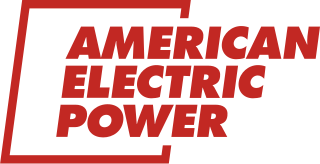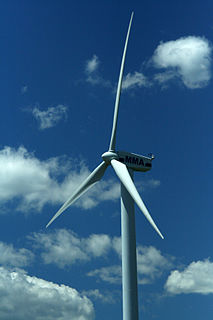Wind power in Arkansas remains nearly untapped, with just a single wind turbine in the state. [1] [2] Arkansas does not have a renewable portfolio standard. [3] Studies have concluded that while Arkansas is generally considered to have low wind resources, there are significant pockets of it throughout the state. [4] [5]
The Arkansas Electric Cooperative Corporation (AECC) purchases electrical power from wind farms outside the state, including [6] 51MW from Flat Ridge 2 Wind Farm in Kansas. [7] [8] In 2013 AECC entered a long-term agreement to buy 150 megawatts of wind energy from Oklahoma from the RES Americas-built Origin Wind Farm, which has 75 turbines in Murray County and Carter County, Oklahoma, and came on line at the end of 2014. [9] [10] It was taken over by Enel. [11]
In 2018, SWEPCO, an Arkansas utility, faced opposition to its $4.5 billion Wind Catcher project, [12] [13] and indicated that ads opposing the project were being sponsored by an unknown non-profit, "Protect Our Pocketbooks". [14]
SWEPCO entered a settlement in which it agreed to "provide a number of guarantees, including a cap on construction costs, qualification for 100 percent of the federal Production Tax Credits, [and] minimum annual production from the project." [15]
The Wind Catcher project involved "acquisition of a 2,000-megawatt wind farm under construction in the Oklahoma Panhandle and construction of a 360-mile dedicated generation tie line to the Tulsa area, where the existing electrical grid ... [would] deliver the wind energy to customers." [14]
The Wind Catcher Energy Connection project was approved by the Arkansas Public Service Commission and the Louisiana Public Service Commission in 2018. [16] [17]
Arkansas is home to one wind energy company, LM Windpower, which builds wind turbine blades at a plant in Little Rock, [18] and to 12 facilities involved in the wind energy industry, such as PPG Industries and ABB. [19]
A 100-foot wind turbine near Prairie Grove was the only turbine in the state. [20]
It is estimated that Arkansas could install 9,200 MW of wind generation capacity based on 80 meter hub height turbines. This could potentially generate 26.906 TWh of electricity each year. [21] In 2015 Arkansas used 46.346 TWh of electricity. [22] Raising the hub height to 110 meters, though, vastly increases the potential to 180,978 MW, capable of generating over 555 TWh of electricity each year. [23]

American Electric Power (AEP), is a major investor-owned electric utility in the United States, delivering electricity to more than five million customers in 11 states.

Denmark was a pioneer in developing commercial wind power during the 1970s, and today a substantial share of the wind turbines around the world are produced by Danish manufacturers such as Vestas—the world's largest wind-turbine manufacturer—along with many component suppliers. In Denmark's electricity sector wind power produced the equivalent of 47% of Denmark's total electricity consumption in 2019, an increase from 43.4% in 2017, 39% in 2014, and 33% in 2013. In 2012, the Danish government adopted a plan to increase the share of electricity production from wind to 50% by 2020, and to 84% by 2035. Denmark had the 4th best energy architecture performance in the world in 2017 according to the World Economic Forum, and the second best energy security in the world in 2019 according to the World Energy Council.

As of December 2017, installed capacity of wind power in the European Union totaled 169.3 gigawatts (GW). In 2017, a total of 15,680 MW of wind power was installed, representing 55% of all new power capacity, and the wind power generated 336 TWh of electricity, enough to supply 11.6% of the EU's electricity consumption.

Hawaiian Electric Industries, Inc. is the largest supplier of electricity in the state of Hawaii, supplying power to 95% of Hawaii's population through its electric utilities: Hawaiian Electric Company, Inc., Hawai'i Electric Light Company, Inc. and Maui Electric Company, Limited. In addition, HEI owns a financial institution serving Hawaii, American Savings Bank.

Wind power in Texas, a portion of total energy in Texas, consists of over 150 wind farms, which together have a total nameplate capacity of over 30,000 MW. If Texas were a country, it would rank fifth in the world: The installed wind capacity in Texas exceeds installed wind capacity in all countries but China, the United States, Germany and India. Texas produces the most wind power of any U.S. state. According to the Electric Reliability Council of Texas (ERCOT), wind power accounted for at least 15.7% of the electricity generated in Texas during 2017, as wind was 17.4% of electricity generated in ERCOT, which manages 90% of Texas's power. ERCOT set a new wind output record of nearly 19.7 GW at 7:19 pm Central Standard Time on Monday, January 21, 2019.

According to preliminary data from the US Energy Information Administration, renewable energy accounted for about 12.6% of total primary energy consumption and about 19.8% of the domestically produced electricity in the United States in 2020.
Wind power in Ohio has a long history, and as of 2016, Ohio had 545 megawatts (MW) of utility-scale wind power installations installed, responsible for 1.1% of in-state electricity generated. Over 1000 MW more were under construction or pending approval. Some installations have become tourist attractions. There has been a sudden increase in generating capacity, as total wind power capacity in the state was just 9.7 MW in 2010. By 2019, there were 738 MW of capacity, which generated 1.71% of Ohio's electricity.
There are a number of wind power projects in the state of Maine, totaling more than 900 megawatts (MW) in capacity and responsible for 13.85% of in-state electricity production in 2017. In 2019, Maine had more wind capacity than the other five New England states combined, at 923 MW.

Norway is a heavy producer of renewable energy because of hydropower. Over 99% of the electricity production in mainland Norway is from 31 GW hydropower plants. The average hydropower is 133 TWh/year. There is also a large potential in wind power, offshore wind power and wave power, as well as production of bio-energy from wood. Norway has limited resources in solar energy, but is one of the world's largest producers of solar grade silicon and silicon solar cells.

Wyoming has one of the highest wind power potentials of any state in the United States. As of 2016, Wyoming has 1,489 megawatts (MW) of wind powered electricity generating capacity, responsible for 9.42% of in-state electricity production. Wyoming produced of 3,800 GWh in 2015, about 9% of the total.
Wind power in Indiana was limited to a few small water-pumping windmills on farms until 2008 with construction of Indiana's first utility-scale wind power facility, Goodland with a nameplate capacity of 130 MW. As of September 2017, Indiana had a total of 1897 MW of wind power capacity installed, ranking it 12th among U.S. states. Wind power was responsible for 4.8% of in-state electricity production in 2016.
GE Wind Energy is a branch of GE Renewable Energy, a subsidiary of General Electric. The company manufactures and sells wind turbines to the international market. In 2018, GE was the fourth largest wind turbine manufacturer in the world.
In 2016, Arizona had 268 megawatts (MW) of wind powered electricity generating capacity, producing 0.5% of in-state generated electricity.

The U.S. state of Massachusetts has vast wind energy resources offshore, as well as significant resources onshore. The 2016 update to the Clean Energy and Climate Plan had a goal of reducing 1990 baseline greenhouse gas emissions levels by 25% by 2020. Current goals include installing 3,500 megawatts (MW) of offshore wind power in the state by 2035. However, as of Q4 2021 the state had only 120 MW of wind powered electricity generating capacity, responsible for generating 0.9% of in-state electricity production. The state has awarded contracts to two offshore projects, the 800 MW Vineyard Wind project and 804 MW Mayflower Wind project. Construction began on the Vineyard Wind 1 project on November 18, 2021, after a long fight for approval.

Energy in Jordan describes energy and electricity production, consumption and import in Jordan. Jordan is among the highest in the world in dependency on foreign energy sources, with 96% of the country's energy needs coming from imported oil and natural gas from neighboring Middle Eastern countries. This complete reliance on foreign oil imports consumes a significant amount of Jordan's GDP. This led the country to plan investments of $15 billion in renewable and nuclear energy. To further address these problems, the National Energy Strategy for 2007-2020 was created which projects to boost reliance on domestic energy sources from 4 per cent to 40 per cent by the end of the decade.
Solar power in Oklahoma can provide 44.1% of all electricity used in Oklahoma from 19,300 MW of rooftop solar panels. This scenario is extremely unlikely though because the cost of electricity in Oklahoma is among the lowest in the nation.

The U.S. State of Oklahoma has high potential capacity for wind power in the western half of the state. In 2017, Oklahoma's installed wind generation capacity was almost 7,500 megawatts, supplying almost a third of the state's generated electricity.

Wind power in Tennessee, which has significant potential in East Tennessee, is in the early stages of development. The state has not passed renewable portfolio standard legislation and there is just one utility-scale wind farm with 18 turbines. The Tennessee Valley Authority (TVA), based in Knoxville, imports wind-generated electricity into its service area which includes Tennessee. US Senator Lamar Alexander from Tennessee is an outspoken critic of wind power.